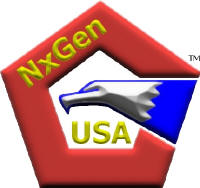

Presents
The Science of SpecAm (Special Operations Camouflage)
|
Patterns may be licensed only with permission.
MARPAT (U.S. Marine Corps Pattern) was developed based on research from Lt. Col. Timothy R. O'Neill, Ph.D. (U.S. Army, Ret.) considered to be the foremost expert on camouflage in the world. CADPAT (Canadian Disruptive Pattern) was developed a number of years earlier than MARPAT but also cities O'Neill's work as the basis for the digital pattern. While both patterns and the new ARPAT (U.S. Army Pattern - three color variant of MARPAT) factored in Lt. Col. O'Neill's ideas of the pixalated micropattern, his research on the symmetry disruption of the human target shape with the larger Macropattern was not implemented into any of these patterns. The slide below is Lt. Col. O'Neill's research from The U.S. Marine Corps site on MARPAT development (References at end). Note his optimal pattern to disrupt the human shape was not included in MARPAT:
This photo below of the HyperStealth SpecAm Tropical (Jungle) Camouflage
This simulation below of the SpecAm woodland pattern shows the disruption more clearly than the tropical jacket. Note the combination of Lt. Col. O'Neill's recommended pattern lines and Guy Cramer's fractal pattern (geometric feedback loop) elements. You may need to blur your vision to see the ambient vision effect.
Effective
camouflage is not just common sense. Proper design and development require
a knowledge of how the eye and brain work.
Dealing
with a target involves two steps: detecting a target and
recognizing the target.
•When
we detect a target, we are simply spotting something that does not
belong. It may be a valid target (“detection”) or it may not be
anything of interest (“false alarm”).
•Two
parallel visual systems deal with detection and recognition; was can
call these the focal and the ambient.
•Understanding
how these processes work is essential to understanding camouflage.
•The
ambient system is an ancient way of seeing, one that evolved long
before the focal. It has been described as the “where is it?”
system, and has a distinct anatomical pathway (the
tectopulvinar). It draws most of its information from the area
around the center of vision, and is critical to detection.
•The
focal (“what is it?”) system is clustered near the center of
vision. Once something has been detected by the ambient, the eye
moves the focal system on the spot to decide what it is. This is
the recognition step.
•Two
camouflage strategies are necessary: one for the ambient (Macropattern) and one
for the focal processes (Micropattern)...
Lt. Col. O'Neill spoke about the pixalated effect: "Digital" camouflage is actually a misnomer, based on the superficial resemblance of these patterns to quantized or coarse digital images. In fact, the patterns of squares (or whatever shape we use) is employed to model the texture of typical backgrounds using a mathematical function. We could use hexagons or shapeless blobs as well, except that it is easier to render complex patterns by computer using squares. It is easy to misunderstand the purpose and mechanisms of this kind of design, which is why so many measures that try to use the approach without insight fall short. Companion Article: Something Wicked This Way Comes: New Special Operations (SpecAm) Digital Camouflage Press Release September 22, 2005: HyperStealth® Camouflage goes Biotechnical New Article October 1, 2005: Desert Vipers in the Sand - SpecAm Desert Viper revealed New Article October 9, 2005: Satellite Determined - Regional Specific SpecAm™ Camouflage New Article October 16, 2005: SpecAm HCD™ (High Contrast Disruption™) Woodland New Article November 13, 2005: SpecAm Desert Jackal Camouflage HyperStealth News November 24, 2005: SpecAm Production Announcement For more Camouflage news go to the HyperStealth® Home Page References: http://www.uniteddynamics.com/dualtex/ http://www.marcorsyscom.usmc.mil/sites/marpat/IntegratedSlide7.asp http://www.marcorsyscom.usmc.mil/sites/marpat/marpat_pattern.asp http://hyperstealth.com/digital-design/index.htm Actual SpecAm Uniforms, see: HyperStealth® SpecAm™ - Tropical |
This page and information © Copyright 2005,Guy Cramer,Timothy R. O'Neill, All Rights Reserved.
CADPAT is a Trademark of the Canadian Government
MARPAT is a Trademark of the U.S. Marine Corps
ACUPAT is a Trademark of the U.S. Army
HyperStealth is a Registered Canadian Trademark of HyperStealth.
"SpecAm" is a Trademark of HyperStealth® Biotechnology Corp.